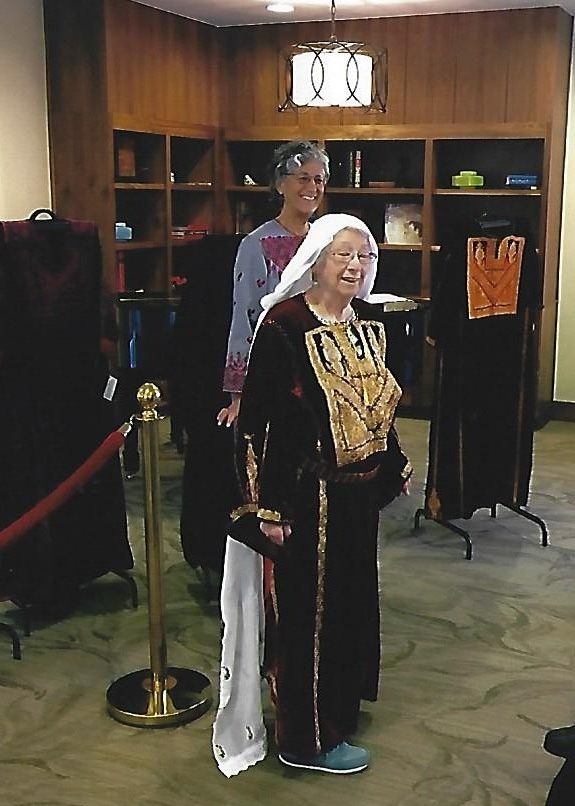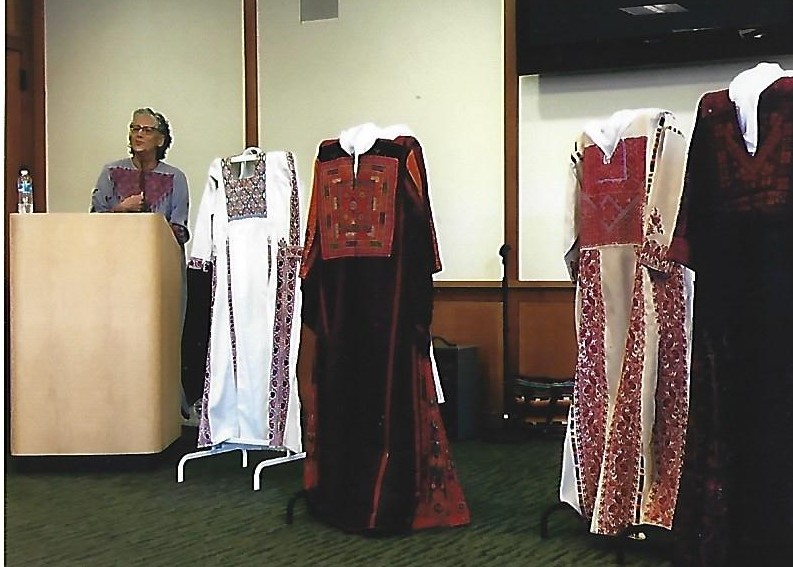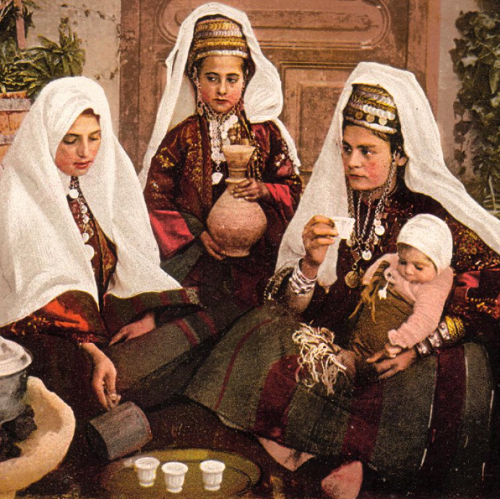Betsy Rich Gilon, an Occupational Therapist and cultural arts educator from Northern California, shares how her chance encounters with a Palestinian embroidered dress in Jerusalem, back in 1970, changed her life forever. Her story of
Threading Peace is one of shared kinship and compassion, or as she calls it “The Garden of Humanity.”
“Working in the garden of humanity is something I know. Ours was a home where we were taught to respect all people
and to make a difference in this world for the betterment of all. If we, as fellow human beings would listen
and feel each other’s stories, our world could be a much gentler and kinder place to delight in.”
Betsy with two Palestinian friends and their children in a village near Jerusalem
The storyteller within
Betsy remembers vividly the first time she experienced a Palestinian dress in Al Quds, Jerusalem, as a young woman, a dreamer.
“This is important, as we carry memories such as this forever in our senses, which can later grow into extraordinary gardens. As I pen this, I can feel the patter of my heart, the scents swirling around me – visions of indigo
Indigo: (Latin: Indigo – India, synonym: nil
Nīl: (Latin: indigo), Arabised term for Indigo, a natural dye belonging to the ‘Indigofera Tinctoria’ species of plants that have been cultivated in East Asia, Egypt, India, and Peru since antiquity. According to Pliny the Elder, it was named after India as it was the source of the dye.), a natural dye belonging to the ‘Indigofera Tinctoria’ species of plants that has been cultivated in East Asia, Egypt, India, and Peru since antiquity. According to Pliny the Elder, it was named after India as it was the source of the dye. , the scent of the fruit stalls, cardamom and mint, the sweetness lingering in the early morning Jerusalem sun.”
The dresses spoke to her with their beauty, the passion palpable and a chorus of voices calling out to her as though they were waiting for this moment in time.
“My heart was open and I knew then that I wanted to learn about the culture and the women who embroidered these amazing dresses. I was haunted by the image of these dresses swaying, along the narrow alleys. Why were these beauties being sold? Every stitch a work of such love, pride and joy.”
It is one thing when traditional embroidered clothing is specifically made to be sold to tourists. This was quite another. I may have been naïve, but Betsy realised there was a story behind these dresses that she knew nothing about. These stories longed to be told.
“There was work to be done, I wanted to make a difference. My heart was full.”
[Image: Betsy with Widad]
The Journey Begins
Several years later, Betsy navigates the hills of Amman, seeking out a teacher, a woman of wisdom. She was told that this woman was gracious and the right person to speak to. It was Widad Kawar, and she took Betsy under her wing.
“The first time she took dresses out of her trunk, I was mesmerised. With a sketchbook in hand, I knew this was to be my destiny. Through her mentorship and friendship, we formed a bond that we share to this day. My experiences in Amman opened my eyes and I began to focus on how I would give life to this dream that would later become, Threading Peace.” Widad had a dream too, and it became what is now the
Tiraz Centre.
Betsy Gilon with her collection of dresses.
My Embroidered Garden
Betsy’s collection of dresses grew alongside her deep love and respect for Palestinian culture.
“My approach is from the heart, it is a human story. I tell of the joy and of the struggles each dress has seen.” Betsy presents educational talks, called
Threading Peace to various organisations both secular and religious, peace camps, schools, and anyone who might be interested. Her philosophy is ‘culture needs to be taught and as the youth are our future, it is their voices that will echo through time.’
Betsy’s dresses are fantastic ambassadors. They tell the story of Palestine through the art of embroidery and fabric. It is a story full of conflict, there are tears but there is also great warmth and beauty. This is Betsy’s way to build bridges, educate, and be peacemakers in a world where there’s justice and respect for all people. She has since added Syrian dresses and her only Yemen dress to the talks, as these dresses need to tell their stories too, sending their voices out to the world.
“Through art, we can create multi-sensory experiences that can open the eyes and minds of those who want them to remain so stubbornly shut.” “As lovers of our collective cultures, we must never forget who we are and where we come from. We carry a responsibility to take a step further and to use our collections to also teach tolerance. I have gathered my collection of dresses mainly from my friendships with Palestinians who want their story to be told in beauty. Beauty has a lens of its own and when we experience it, our world is in harmony. We can see with fresh eyes and an open heart.” Betsy teaching the children. I
Threading Peace - My Passion
“For many years I taught programs to school children as a ‘travelling teacher” organised through a local museum. With this program, I went into the classrooms with my dresses giving me an intimate space in which to engage both the children and their teacher. It gave me access to children from different backgrounds who might otherwise not get this kind of exposure.”
Betsy taught two different programs, one program compared four cultures from different regions of the world, and the other was focused on Arab culture where her Palestinian costumes were the centrepiece.
Betsy believes that in these difficult times, it is important to keep in mind that we are not only educating each other as adults, but also our children. This is a great responsibility as the children are our future.
"They need to learn at a young age that we are all human, with families, hopes, dreams for the future, and all that goes with living on this earth in harmony. We must teach them to appreciate and respect all peoples everywhere. All humanity has the same basic needs in life even though we come from different cultures. We are bombarded with stereotypes that obscure peace education and contribute greatly to creating disharmony in our world. By teaching this approach, it enriches the children’s lives as well as our own."
Setting the scene
For Betsy enthusiasm and passion are key. She believes that if the teacher radiates love for their subject, the rest falls nicely into place. Imagination and thinking out of the box are essential. This is a challenge Betsy really enjoys and she has put together a set of ‘tools’ for her presentations:
“I decorate my space with the costumes, woven items, photographs, and anything that is unique and will capture their attention, and I always wear one of the dresses. I simply go through the dresses and the everyday items around me using each item as a prop from which I tell its story. It is essential to work with the audience while keeping it flexible for children of different ages. You have to keep the children engaged, curious and animated, bringing your personality into play. I use body language a lot, projecting that I am having fun and that I want the children to also have fun. Being able to “go with the flow” is so important. One never knows how the audience will react. I try to bring humour into the room as much as I can and let the children try on clothing, which always brings on the laughter. It’s all about having a buffet of sensory experiences as, without it, the children will not stay engaged.” “When I am in front of a group of eager school children I have various items that can be the impetus for some wonderful cross-cultural learning. A Bedouin woven bag, for instance, where we compare the similarities of terrain, climate, colours, and how that might influence the weavers. I take articles of clothing and talk about why the people from these regions wear the clothing that they do. There is so much that connects us all and I try to thread it together so they see we are all so very similar. I will sometimes play recordings of Arabic music or maybe even teach a little dabke dance. I love taking this room full of eager faces on a journey that they will remember long after.” “Typically, the teachers have prepped their classes before I come and I bring handouts for the teachers to use later as teaching tools. You can make your own word search, a simple crossword puzzle, or pictures to colour. I have an old coffee pot that I bring with me that is full of soot and has a story to tell. While telling the story, I ask the kids, ‘If this pot could talk, what stories would it tell?’ The teacher will later use this and have the children write an essay of what the pot would say and I will often receive a bundle in the post full of the most beautiful stories. It makes my heart sing, as this is what I want to see, the creative spirit emerging. On one occasion while in a local market, a young man approached me. He remembered when I came to his class several years ago with ‘all the interesting things and clothing.’ I was thrilled, it meant so much to me.”
“Typically, the teachers have prepped their classes before I come and I bring handouts for the teachers to use later as teaching tools. You can make your own word search, a simple crossword puzzle, or pictures to colour. I have an old coffee pot that I bring with me that is full of soot and has a story to tell. While telling the story, I ask the kids, ‘If this pot could talk, what stories would it tell?’ The teacher will later use this and have the children write an essay of what the pot would say and I will often receive a bundle in the post full of the most beautiful stories. It makes my heart sing, as this is what I want to see, the creative spirit emerging. On one occasion while in a local market, a young man approached me. He remembered when I came to his class several years ago with ‘all the interesting things and clothing.’ I was thrilled, it meant so much to me.”
Betsy’s last advice is
“The internet is full of resources. Do not be afraid to use your imagination. Remember the child within and go for it. These ideas work well and can be tailored to the age group you are with. Let us teach our children with purpose. It is within our reach to make a difference. Teaching peace with imagination and creativity is powerful. We have it inside, just waiting to burst forth.” 
From the Author
“This passion of mine was kindled even before my first visit to the Middle East. I was wearing embroidered clothing from Mexico and other indigenous cultures in my youth. My love of Arabic culture extended to folk dance and I was the costumier for the Almas Arabic Folk Ensemble in Los Angeles, California. Through the years I have presented my dresses to universities, museums, peace organisations, and other groups throughout California. I was a Traveling Teacher, going into numerous classrooms where I presented to many school children. It was here that I used my education as an Occupational Therapist to create a unique, hands-on experience for the students. I will continue to share the stories of the dresses to educate all who will listen about this beautiful culture.”






